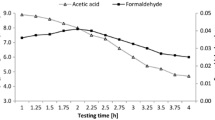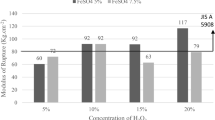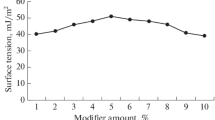Abstract
For the development and modification of low-emission binder systems for the woodworking industry a fast and simple determination method of the formaldehyde emission potential is essential. Up to now, the evaluation of glues has been complicated by long-winded and laborious methods. During panel manufacture, the hot pressing parameters significantly affect the long-term formaldehyde emission. Consequently, a comprehensive optimization of the pressing process is necessary to enable statements on the binder’s emission potential. Hence, this production step is skipped in primary binder development. For the method presented here, glued particles are hardened in a conventional laboratory drying chamber without pressing. Afterwards, the samples are analyzed in a bleached tea bag following the flask method EN717-3 (CEN 1996). With this approach, rapid determination of the formaldehyde emission potential is possible. From these results, a ranking of binders can be established, based on which an experimental design for subsequent measurements including chamber tests can be set up.
Zusammenfassung
Für die Entwicklung und Modifizierung von Niedrigemissions-Bindemittelsystemen ist es zunehmend notwendig, über eine schnelle und einfache Bestimmungsmethode für Emissionspotential eines Leimes zu verfügen. Bis dato waren für die Beurteilung eines Leimsystems im Verbund nur relativ träge Methoden vorhanden. Vor allem beim Pressen einer Platte bestimmen die Pressparameter die nachträgliche Formaldehydemission (z. B. Zeit und Temperatur). Somit muss für ein gegebenes Leimsystem der Pressvorgang jedes Mal optimiert werden, um eine detaillierte Aussage über das Emissionspotential eines Leimes treffen zu können. Daher wird versucht, auf diesen Vorgang zu verzichten. Anstatt dessen werden die beleimten Späne in einem gewöhnlichen Trockenschrank ohne zu pressen gehärtet und im Anschluss in einem Teebeutel nach der Flaschenmethode EN717-3 vermessen. Relativ zu einem Referenzsystem (z. B. Harnstoff-Formaldehyd Leim) können nun rasch Aussagen über das Emissionspotential eines Leimsystems bzw. eines Additivs gemacht werden. Ausgehend von diesen Emissionswerten kann eine Reihung möglicher Additive zur Formaldehydreduktion vorgenommen und ein detailliertes Versuchsprogramm inklusive Kammermessungen aufgestellt werden.






Similar content being viewed by others
References
(CARB) Californian Air Resources Board (2008) Airborne toxic control measure to reduce formaldehyde emissions from composite wood products
CEN (1994) Wood based panels—determination of formaldehyde release—Part 2: Formaldehyde emission by the gas analysis method. EN 717-2. European Committee for Standardization, Brussels
CEN (1996) Wood based panels—determination of formaldehyde release—Part 3: Formaldehyde emission by the flask method. EN 717-3. European Committee for Standardization, Brussels
CEN (2005) Wood based panels—determination of formaldehyde release—Part 1: Formaldehyde emission by the chamber method. EN 717-1. European Committee for Standardization, Brussels
Committee on Harmonized Technical Prescriptions for Construction (1980) Guideline on the use of particleboard with regard to the avoidance of unacceptable formaldehyde concentrations in indoor air
Dorner F, Wuzella G, Unterweger C, Müller U (2010) Curing control of aminoplastic resins by model-free kinetics. Holztechnologie 51:11–15
Dunky M (1998) Urea-formaldehyde (UF) adhesive resins for wood. Int J Adhes Adhes 18:95–107
Dunky M (2005) Resins for ultra-low formaldehyde emission according to the Japanese F**** quality. In: Proceedings of wood adhesives, pp 343–349
Federal Ministry of Environment Youth and Family Affairs of Austria (1990) Formaldehyde regulations order. BGBl, Nr 194/1990
IKEA of Sweden (2008) Formaldehyde requirements of wood-based materials. IOS-MAT-0003, AA-10899-6
Kelly MW (1977) Critical literature review on relationships between processing parameters and physical properties of particleboard. General Technical Report FPL-10 32-36, Madison, WIS, US Department of Agriculture Forest Service
Krug D, Tobisch S (2010) Use of proteins as binders for wood-based panels. Eur J Wood Prod 68:289–301
Ministry of Land Infrastructure and Transport Government of Japan (2003) The amended building standard law on sick houses issue and applications for recognition of overseas performance evaluation organisation
Moser J, Glann M, Kanter W (2008) Melamine-urea-formaldehyde resins as binder for low formaldehyde emission particleboards. Holztechnologie 49:36–42
Nash T (1953) The colorimetric estimation of formaldehyde by means of the Hantzsch reaction. Biochem J 55:416
Roffael E (1975) Messung der Formaldehydabgabe – praxisnahe Methode zur Ermittlung der Formaldehydabgabe harnstoffformaldehydharzgebundener Spanplatten für das Bauwesen. Holz-Zentbl 101:1403–1404
Roffael E (1993) Formaldehyde release from particleboard and other wood based panels. Malayan Forest Records 37
Roffael E, Johnsson B, Engström B (2010) On the measurement of formaldehyde release from low-emission wood-based panels using the perforator method. Wood Sci Technol 44:369–377
Sundin B, Manson B, Endrody E (1987) Particleboard with different content of releaseable formaldehyde. A comparison of the board properties, including results from four different formaldehyde tests In: Proceedings of the 21st international particleboard symposium. Washington State University, Pullman, USA, pp 139–185
Yu CWF, Crump DR (1999) Testing for formaldehyde emission from wood-based products—a review. Indoor Built Environ 8:280–286
Acknowledgements
The author would like to thank for the support of the Competence Centre for Wood Composites and Wood Chemistry (Wood K plus, Kompetenzzentrum Holz GmbH, Austria) and the Institute of Polymer Chemistry of the Johannes Kepler University Linz, Austria. The scientific work was financed by the COMET program. Special thanks to Borealis Agrolinz Melamine GmbH and Dynea Austria GmbH for material support.
Author information
Authors and Affiliations
Corresponding author
Rights and permissions
About this article
Cite this article
Dorner, F., Berger, D., Müller, U. et al. Rapid determination of formaldehyde emission potentials of binders for the woodworking industry. Eur. J. Wood Prod. 70, 299–306 (2012). https://doi.org/10.1007/s00107-011-0558-7
Received:
Published:
Issue Date:
DOI: https://doi.org/10.1007/s00107-011-0558-7




